Media | Articles
The V-12 and V-16 Progeny of Chevy’s Small-Block V-8
In the last seven decades, General Motors has bestowed 113 million small-block V-8 engines upon us—nearly one per American household. Given this engine’s phenomenal success, it’s no surprise that its fundamental architecture and pushrod-actuated, two-valve technology have been stretched and transformed into ambitious projects far exceeding original displacements and cylinder count. A few of these engines have been featured in high-profile builds or found their way into boats or airplanes, but all of them displayed serious ingenuity.
V-12s Then and Now
After running Andy Granatelli’s Indy racing engine program and then collaborating with Carroll Shelby for several years, Ryan Falconer opened his own shop in Culver City, California, in 1966. That year, the Ford Racing V-8 he built powered Graham Hill to an Indy 500 victory. In 2011, Falconer relocated to Chino Valley, Arizona, where this 83-year-old motor maestro is still at it.
Falconer unveiled his V-12, based on the first-generation Chevy small-block V-8, back in 1990. A Corvette powered by this engine topped 200 mph, and another Falconer V-12 propelled the Thunder Mustang, a ¾-scale P-51 aircraft. Prices started at $85,000.

Falconer retained Chevy’s 4.40-inch bore spacing, single camshaft, and pushrod-operated two valves per cylinder. His block and heads were cast aluminum, limiting weight to 520 pounds. This V-12’s crankshaft was machined from a chunk of billet steel and secured in place by a girdle incorporating all seven main bearing caps. A few of Falconer’s engines were supercharged or turbocharged, and dry-sump lubrication was also available. Displacements ranged from 8.6 to 9.8 liters, with naturally aspirated power outputs up to 640 hp at 4500 rpm. One supercharged 8.2-liter V-12 produced nearly 1000 hp in a marine application.


In addition to their power potential, every V-12 has perfect primary and secondary harmonic balance. The only flaw in V-12s descending from 90-degree V-8s is their unequal firing intervals. Instead of a power pulse every 60 degrees of crank rotation, the cylinders light off every 30 or 90 degrees. The Dodge Viper’s V-10 also suffered from this fault, though it never stunted that rabblerouser’s personality. Of course, GM understood the virtues of a 60-degree bank angle, which is why that arrangement was used in V-12–powered GMC trucks in the 1960s.
Marketplace
Buy and sell classics with confidence
Over 35 years, Falconer built and sold 55 of his V-12s for auto, marine, and aircraft applications. Currently, he’s focused on selling the Falconer L6, a 5.0-liter DOHC 24-valve inline-six originally built by GM for motorsports.
The V-12 from Down Under
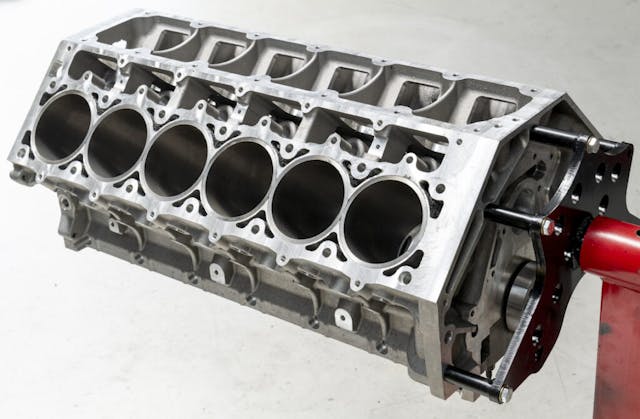
Proving that excellence can have global reach, two Australian entrepreneurs have taken up where Falconer left off. In 2018, Matt and Shane Corish’s Race Cast Engineering in Melbourne began offering V-12s based on GM’s fourth-generation small-block LS V-8. This March, one of their engines sparkled at Detroit’s Autorama under the hood of the TwelveAir sports coupe built by Kindig-It Design of Salt Lake City, Utah. Owners Dave and Tracey Maxwell, of Saltsburg, Pennsylvania, carted home the $10,000 Ridler award won by their TwelveAir creation.
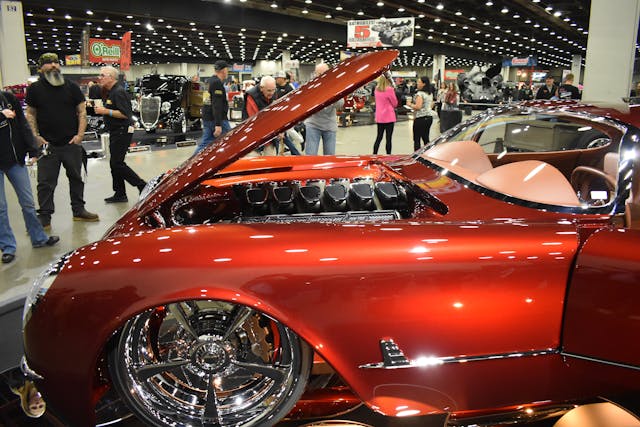
Shane Corish notes, “GM’s superb small-block V-8 provided the perfect starting point for our V-12.” Race Cast uses modern 3D printing technology to cast its blocks in aluminum or iron. (The latter is preferable for boosted applications.) While standard GM 4.40-inch bore spacing is maintained, extra head bolts have been added for improved durability, and the sides of the cast aluminum oil pan are a full inch thick to increase this V-12’s longitudinal stiffness. A Haltech Nexus electronic control unit runs the ignition and fuel injection, while induction air flow is regulated by a standard GM throttle body.
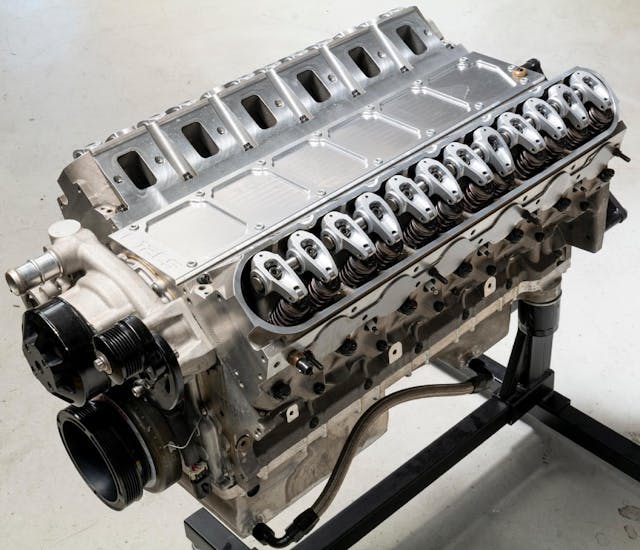
The Aussie V-12s are available as a $49,300 engine builder’s kit, with the block, heads, crankshaft, camshaft, and gaskets included. A smaller-bore aluminum block can be had for an additional $5000. Power outputs range from 750 hp in the base naturally aspirated 9.5-liter (580-cubic-inch) V-12 up to 1000-plus hp with a 3.90-inch stroke that increases displacement to 9.9-liters (607 cubic inches). Consider this merely the starting point, because Race Cast’s customers have begun toying with boosted engines. One has a quad-turbo build under way, and another has added a pair of Magnuson superchargers.
Small-Block–Based V-16s
Around 2000, GM realized that clever engineering could double its small-block V-8 into a viable V-16. In 2003, the Cadillac Sixteen concept bowed as the center piece of that division’s Art and Science initiative. This effort to nudge Cadillac’s prestige upward evoked the V-16 limos the brand sold from 1929 through 1937.

Tom Stephens, GM’s powertrain operations vice president, guided the XV16’s design and development with an eye toward production. Prototype castings were sourced in Germany, and Katech Performance, the Corvette racing program’s venerable partner, conducted the dyno testing. The goal was a nice round 1000 horsepower and 1000 lb-ft of torque. To reach these lofty heights, the 6.2-liter LS3 V-8’s bore and stroke were both increased 6mm, yielding a 13.6-liter/830-cubic-inch V-16 that weighed a reasonable 695 pounds.
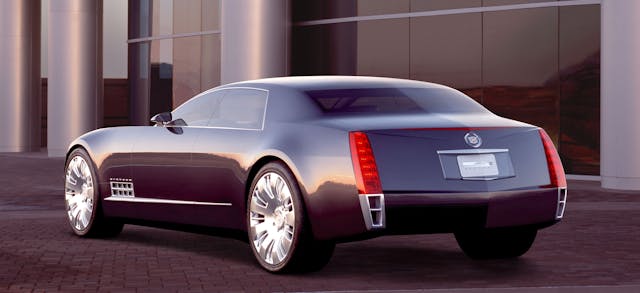
In addition to batting 1000 in output, GM’s XV16 could run on regular fuel and featured “displacement on demand,” which allowed it to cruise on as few as four cylinders. Given full boot, it was allegedly capable of smoking the rear tires of a GMC Yukon durability test vehicle … in three gears.
Unfortunately, GM’s fortunes turned downward shortly after the Sixteen’s arrival. Imports thrived at the domestic brands’ expense. What GM needed more than a Rolls or Bentley beater was a better Chevy Cavalier to fight entry-level Japanese cars. In mid-2009, GM filed for bankruptcy, acknowledging debts twice its assets. By then the remarkable XV16 was but a fond memory.
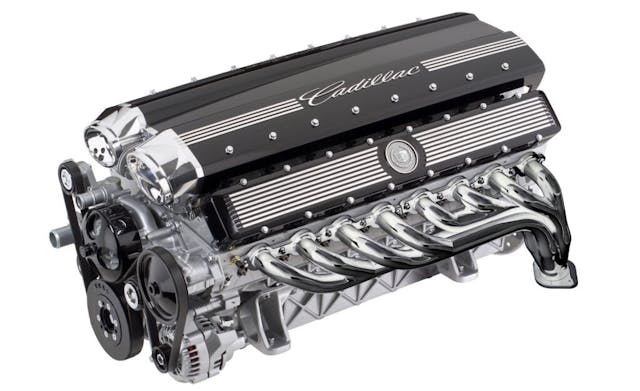
Another Unhappy Ending
At two 2017 Dubai International motor shows, a budding enterprise called Devel unveiled a sports car prototype called the Devel SIXTEEN with over-the-moon aspirations. Its powerplant was said to be a 12.3-liter V-16 equipped with four turbochargers, boosting output over 5000 horsepower while producing 3757 lb-ft of torque.
The feeling, according to Devel, was that of a road-going jet fighter with a 300-mph top speed. While the flagship car was not intended for road use and no price was attached to it, two additional versions were also planned for production: a $1.6-million 2000-hp V-8 edition and a $1.8-million quad-turbo V-16 delivering 4000 horsepower.

According to Devel boss Rashid Al-Attari, the SIXTEEN’s molded carbon-fiber body would be provided by the Italian coachbuilder Manifattura Automobili, and Scuderia Cameron Glickenhaus in New York would construct the space frame chassis. He also credited Steve Morris Engines, a firm located in Muskegon, Michigan, as the engine supplier.
SME has been in business since 2010. Boss Morris filled us in with a few details: “We built and tested a prototype engine which shared the 4.40-inch bore center dimension and basic configuration of GM’s Gen III LS small-block V-8. With a mild camshaft and 20 psi of boost, it produced 3006 horsepower. With 30 psi of boost, it topped 4000 horsepower. Upped to 36 psi, it made 4515 hp, which was all our dynamometer could handle. More than 5000 horsepower was definitely possible here.”
There is video footage of Devels running 100-or-so-mph on test tracks but those prototypes were fitted with Corvette V-8s, not the anticipated V-16. Notes Morris, “Our experimental engine has never been fitted to a car. Unfortunately, Devel seems to have fallen off the face of the earth. From our engine-development perspective, the project ended the same year it began—2017.”
While Devel’s V-16 stretch appears to be unrealistically ambitious, let us ponder two alternatives. The Corvette ZR1 due later this year will build on the Z06’s LT6 5.5-liter DOHC 32-valve V-8 by adding two turbochargers and intercoolers. That new LT7 small-block will bring an estimated 850 hp to the party.
And to all the wildly creative engineers in the audience, we suggest you aim your most advanced CAD/CAM weapons at what we’ll code name LT12 and LT16: engines rising out of the inherent greatness of the Corvette’s LT7 V-8. An 8.2-liter V-12 should produce 1300 hp, while the quad-turbo 10.9-liter V-16 should make 1700 hp … without straining. All the horsepower addicts pondering Devel worship will surely prefer these heavenly alternatives.
***
Check out the Hagerty Media homepage so you don’t miss a single story, or better yet, bookmark it. To get our best stories delivered right to your inbox, subscribe to our newsletters.










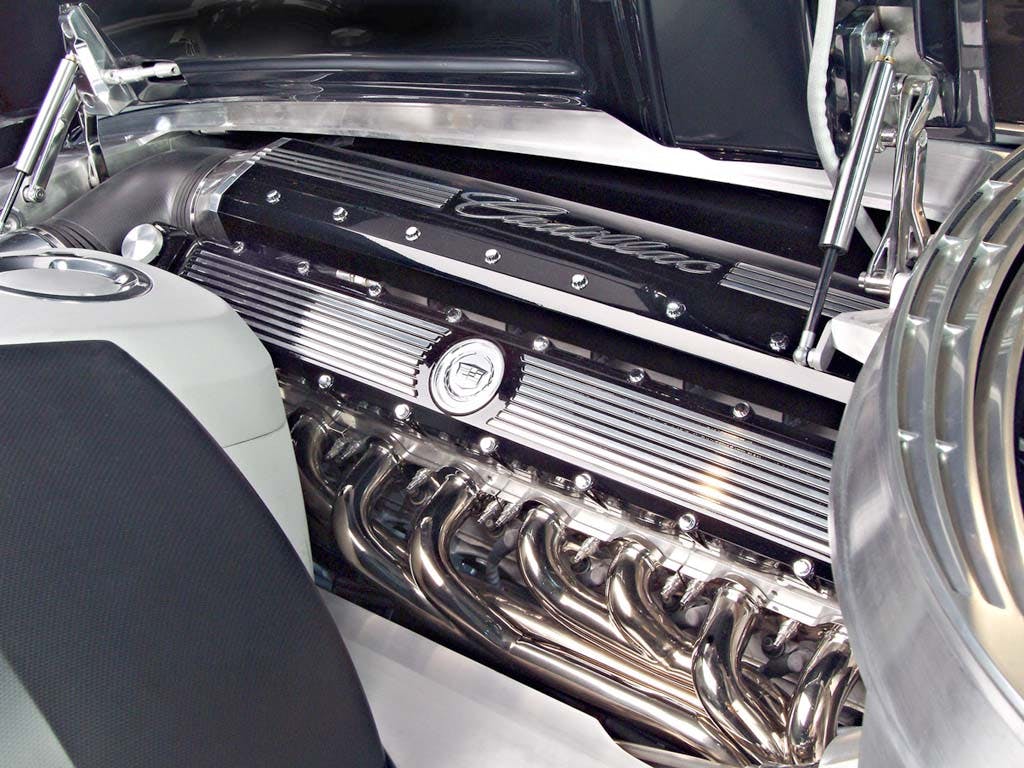



GM also installed a BMW V12 in a Caprice a while back.
I was around for that project. When they were done, there was a brand new 350 V8, with a 4 bbl carb, and a new BMW 760 without an engine. I would have loved to take home those leftovers, but someone beat me to it.
Have stated many times–they could build the Sixteen today just as in the picture and it would still be stunning. BIG mistake not to build that car!
Indeed! Better looking than the Celestiq (spelling?)…. I know how it should be spelled “Fleetwood 16’. Remember seeing this and thinking DAMN.
Sadly there is not much money to be made there. It would not be cheap and the fact the car shown here is an old show car that really could not go more than 35 MPG means it was not production ready.
Cadillac really needed to focus on a car for $70K people would willfully buy vs just a show piece.
Event the Bespoke EV they have coming I feel is a mistake.
You have to earn the right to sell cars at that price.
Hey, if that show car will go 35 MPG, let’s get together with Neil on page 2 and set up an economy marketing plan. It would be the stingiest V-16 in history!
Probably more like a 305 V8 and a 750, the 760 designation came later.
Peters and Nye freight train dragster in 1961 chained two v8s together front to back with a double row chain.
Of course there was Tommy Ivo’s dragster with 4 engines. Buick Nailheads iirc.
Twin-engined dragsters were a hot setup in Top Gas, until NHRA shut the class down in the early 70s.
I think the Cadillac Sixteen had the potential to bring back Cadillac in a big way as a leader but bad timing for an outrageous car seems to be expected at that time.
I had the opportunity to work on both the falconer v12 in the corvette and the Cadillac v16 while I worked for GM from mid 2000 until early 2016. Both of them had fantastic engine’s in them. And yes the Yukon would tear the tires loose in several gears. Little tid bit, they stretched the frame and front clip about a foot to make room for the V16. It was pretty easy to spot on the roads around the Detroit area.
Given the technological capabilities of today. CNC machining in multiple axis. CAD/CAM for post processing of design to machining. 3D printing in a variety of materials designing and build V-12, V-16 or other variations such as W (aka Broad Arrow), VR layouts etc is not only possible outside of the engine development shops of the manufacturers. It can and has bern done. But even today there are small shops hand building custom engines via weld assemblies such as Ardema Braun. I formerly worked with a gentleman who is the lead mechanic for a race team out of NE Illinois. The cars they run use Hart 4 cylinder DOHC engines. They needed new heads. Which are not available. They had them designed, patterns made, castings poured and machined. The major ingredient of course was what beats displacement. Cubic money.
Thanks for a great article which confirms that American ingenuity continues to be strong looking to the future.
The marketplace continues to suggest there is a place for continued development for the internal combustion power train in American motorcars.
The Sixteen is one of Cadillac’s best designs ever, and not building the car will remain one of GM’s biggest fails.
Sort of related: anybody ever recall Jaguar attempted to bolt together two of its six cylinder E Type engines for a straight 12? I think I remember reading about waaaaaay back in Popular Mechanics. What I remember was the length was just too much for any metallurgy or design in the cams and crank to over come
Why no mention of the VW W12 engine? It was a clever bit of engineering.
The Sixteen would have been a show price that could have shown the light on the rest of the line up. But the problem was GM was going broke. We were in 2003 and GM was on the brink of the bail out. Even the 2004 GTO had to forgo a redesign, hood scoops and true duel exhaust on each side as there was no money to do it. Even the gas tank was put in the trunk to get it to pass cheap.
The Cadillac line up was not what it is today and selling a car like the Sixteen would be tough. Getting people to spend that much on a car from a brand that really had not shown they were yet on the right track.
I loved the car and got to see it in action at a large auto event. It was clear the car was a show car but the engine was real. I do recall seeing them tested in SUV models.
GM just had so many other problems that needed addressed before they did something like this. You have to walk before you run.
It did give hope after the Aztek.
Dave Kindig (Kindig-it Design) also dropped the V12 Falconer in a ’58 to ’60 Lincoln Continental if I remember correctly.
The featured Caddy is beautiful. Build that exact sucker with a nice 300 plus HP v-8 & they would have a sales giant!
If GM made the Cadillac16 and I had the money to buy one, I would do it in a heartbeat!! Lines and the look is so sexy, not to mention it comes a v16!! Big mistake on GM not making it a product car in my opinion.